There is so much to see in Ipoh! I lived there for more than 15 years during my formative years and attended both primary and secondary schools there. Many places are familiar to me, but I recently discovered some entirely new spots during my visit. I spent two wonderful days in Ipoh recently, and in this article, I would like to share what I saw and did while there. Here is my list of 15 Places to Visit in Ipoh. Please join me on this journey to visit my hometown.
1. Perak Cave Temple 霹雳洞
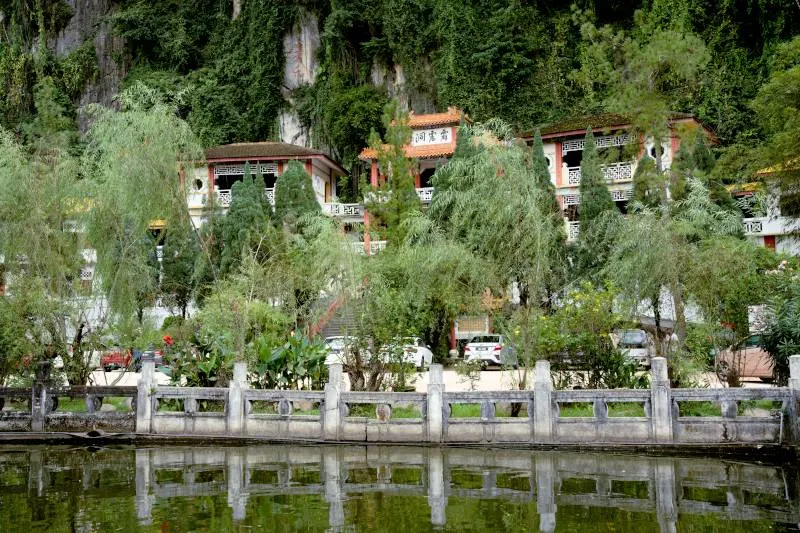
Ipoh is commonly known as the "City of Hills" (山城) due to the numerous hills and mountains that surround it. Most of these are limestone hills, creating many caves filled with stunning stalactites and stalagmites. If you're short on time and can't visit all the temples and caves, I recommend the Perak Cave Temple, which takes the top spot for the best places to visit in Ipoh

I could still vaguely remember the entrance to this temple when I arrived. It hadn't changed; it looked just as it did when I came here with my father when I was young. A large parking area was available at the entrance. Besides it, there is a pond with a statue of Kuan Yin in the center.

Perak Cave was discovered in 1926 by a Chinese named Chong Sen Yee 张仙如. As I entered, we were greeted by a 40-foot-tall Buddha statue. The inner part of the cave features stunning natural limestone formations and houses various statues of deities. Besides, colorful paintings and calligraphic writings created by Mr. Chong and others are on the cave wall.



On the left and right sides of the main hall, there are statues of the Four Great Heavenly Kings, also known as the Four Diamond Guardians 四大金刚. These figures are significant in Buddhist and Taoist traditions, protecting the four cardinal directions. They are often depicted as powerful deities, and you will notice that some demons are being trampled beneath their feet.

Some sculptures and statues inside the cave are clearly labeled, while others remain unmarked, making them difficult to identify without a deep knowledge of Buddhism. One labeled figure is Mahāsthāmaprāpta, a bodhisattva in Buddhism (大势至菩萨).
There is a staircase at the end of the cave, where the ascent to the top begins. The steps leading up to the top of the hill can be pretty strenuous, especially if you're not used to physical activity. I could complete the climb in about 10 to 15 minutes without stopping. Initially, the stairs were well-maintained, but as I went further, they became pretty uneven.

About halfway up, there's a platform with a sign that reads "Halfway Up the Hill" (半山腰). From this point, there are several paths to the top, and I chose one that led me to a viewpoint with a stunning panoramic view of Ipoh town. Not every visitor was inclined to climb, as I encountered only three other people doing the same.

Despite the effort required, the experience was well worth it. It offered a unique perspective that set it apart from the statues and deities in many other temple caves.


2. Ling Sen Tong Temple 灵仙岩
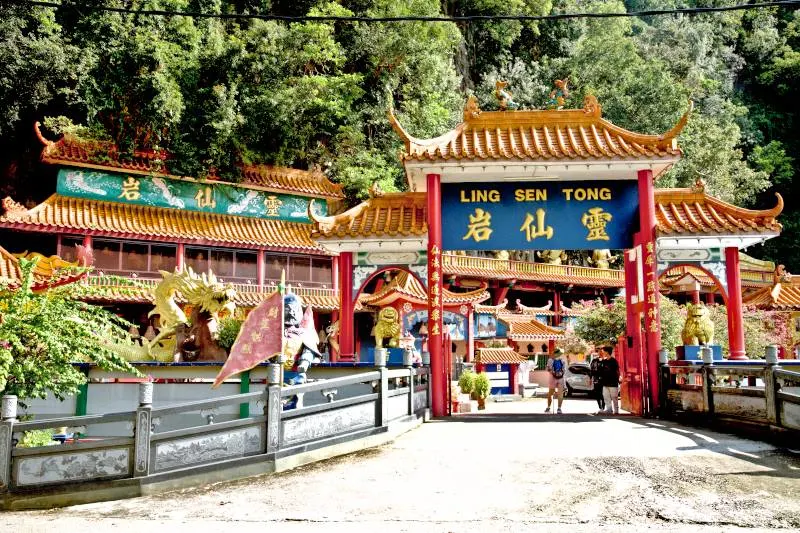
Next, we visited three more cave temples located next to each other, about a 10-minute drive from Mirror Lake. They are Ling Sen Tong Temple 灵仙岩 Nam Thean Tong Temple 南天洞 三宝洞.
The first temple is Ling Sen Tong Temple, which is visible from the main road.
This cave temple is relatively new compared to its neighboring ones, as it was only established in 1967. It is primarily dedicated to the goddess of mercy, Guan Yin.


The Garden of Guan Yin is opposite the main entrance to the cave temple.

Inside the cave, there is a mix of Buddhist and Taoist deities.
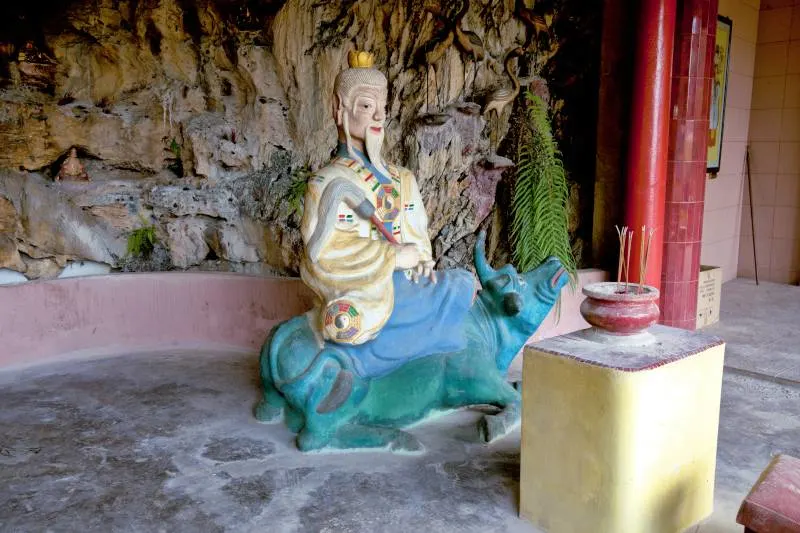
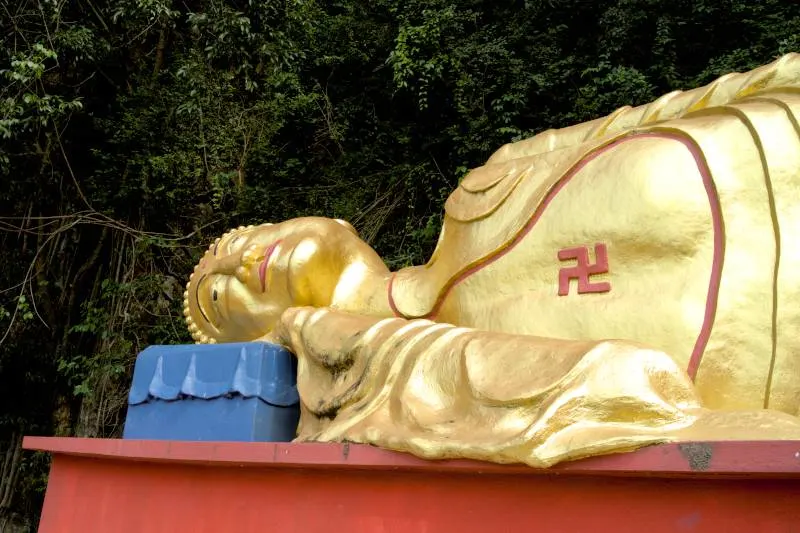
3. Nam Thean Tong Temple 南天洞
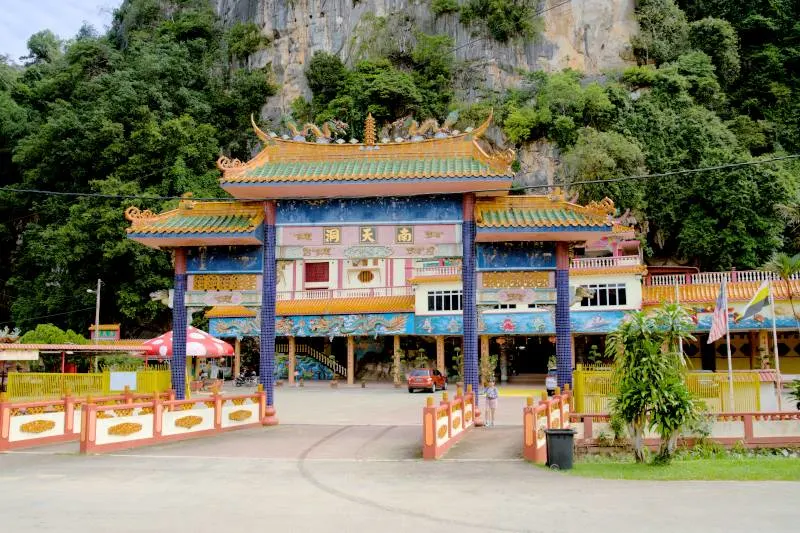
Next to Ling Sen Tong is Nam Thean Tong. This temple is considered one of the oldest and was discovered in 1867 by a tourist named Gong Shande (龚善德). It is dedicated to the founder of Taoism, 太上老君 (Tai Shang Lao Jun).


The temple's main hall leads to another cave at the back. Like the Perak Cave Temple, it also has a staircase leading upwards. However, during my visit, this area was closed for renovation.

There are several levels in the front section to the left of the main hall, although the top level was also closed. I was able to access the third level, where the Eight Immortals (八仙) are depicted.

Note: 太上老君 (Tai Shang Lao Jun) and 老子 (Laozi) are often associated with each other but are not the same. 老子 (Laozi) is a historical figure known as the founder of Taoism, while 太上老君 (Tai Shang Lao Jun) is a deified version of Laozi in Taoist mythology. The figure of 太上老君 is easily recognizable, as he is usually portrayed while riding on an ox.
4. Sam Poh Tong Temple 三宝洞

Sam Poh Tong Temple was discovered in 1890 and is dedicated to the goddess of mercy, Guan Yin. It is similar to the other two temples nearby but is significantly larger and famous.
In addition to the limestone cave, there is a turtle pond where I can feed the turtles.


The main hall also contains statues of the four heavenly kings, numerous murals, and other deities I am unfamiliar with.

If you have limited time or are not interested in visiting all three temples, I recommend pick Sam Poh Tong Cave Temple.
5. GUA KEK LOOK TONG 极乐洞

Another cave temple I visited when I was young was the Kek Look Tong Cave Temple (note: "Gua" means "caves" in Malay). However, when I arrived there, I found it closed, marked by a large banner that stated it was temporarily closed. The banner indicated that the cave had experienced severe flooding but did not specify when it had been put up. As a result, I was unsure how long the cave had been closed. As of today, December 2024, it remains closed until further notice.
6. Historical buildings in Ipoh
The Ipoh Old Town area is home to several colonial buildings, many of which are painted white and have colonial designs. These include landmarks like the clock tower, dedicated to J.W.W. Birch, the first British Resident of Perak.

Another beautiful white building is the Ipoh railway station, renowned for being one of Malaysia's most beautiful railway stations.

The Ipoh Town Hall and the High Court of Ipoh are within walking distance, both of which feature the elegant Edwardian Baroque architectural style. Besides, the Masjid Sultan Idris Shah II is opposite the clock tower.

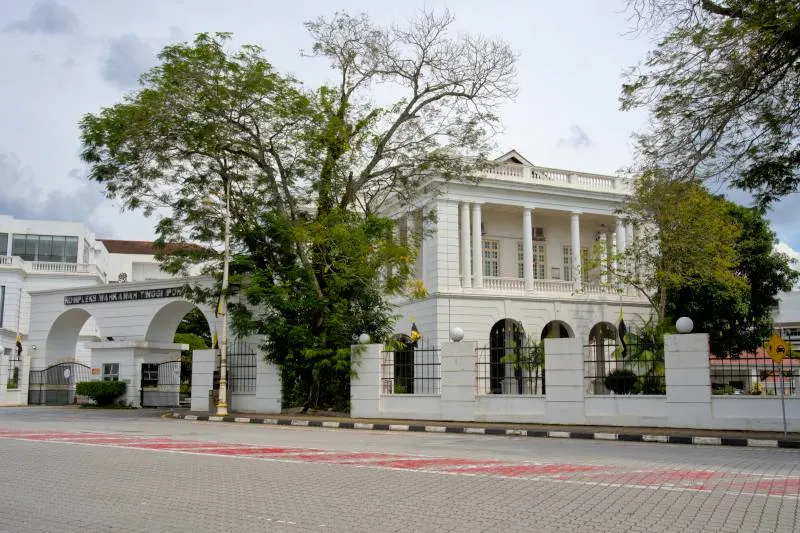
These buildings were quite familiar to me in the past, as I studied at St. Michael Institution nearby, a historical building in Gothic European style. Back then, I often walked past these buildings without truly noticing the intricate details of their design. As I return and face them right before my eyes, I appreciate how beautiful and unique they truly are.

7. Ho Yan Hor Museum

The Ho Yan Hor Museum is a unique attraction in the old town of Ipoh. This shop lot was originally the residence of the founder and factory of the herbal tea brand Ho Yan Hor. The museum displays various posters and displays that depict its history, dating back to its introduction in 1940 by the founder, Dr. Ho Kai Cheong, a well-known merchant in Ipoh who built a large business empire based on his Chinese herbal tea.
The museum has many interactive exhibits and antique artifacts that vividly tell the story of Ho Yan Hor's growth and its impact on Malaysian society.

The Ho Yan Hor herbal tea brand is so popular that nearly every Malaysian Chinese is familiar with it, making the museum particularly attractive to the local community. If you are a foreigner interested in learning more about the culture and heritage of Ipoh, especially the success of Chinese merchants during the World War era, this museum is a must-visit for deeper insights into that history.

8. Han Chin Pet Soo 闲真别墅

Han chin Pet Soo Museum may sound like a petting zoo, but no pets are inside! The term "Pet Zoo" is a direct translation from Chinese, meaning "Villa." The building was constructed in 1893 and served as a recreational center for them; it was founded by a businessman named Leong Fee 梁壁如. Han Chin Villa has now transitioned into a museum.

We book through its website to visit this place, as walk-ins are not allowed. You can pick the guided tour in English or Chinese from the website. While there is no fixed fee, visitors are expected to donate a small amount to support the museum.

The Muzeum is a historic building next to the Ho Yan Hor Museum. Its primary objective is to showcase the work and daily life of the Hakka people who migrated from China to Malaysia in the 19th and 20th centuries. During that period, many Hakka individuals worked in the tin mines.
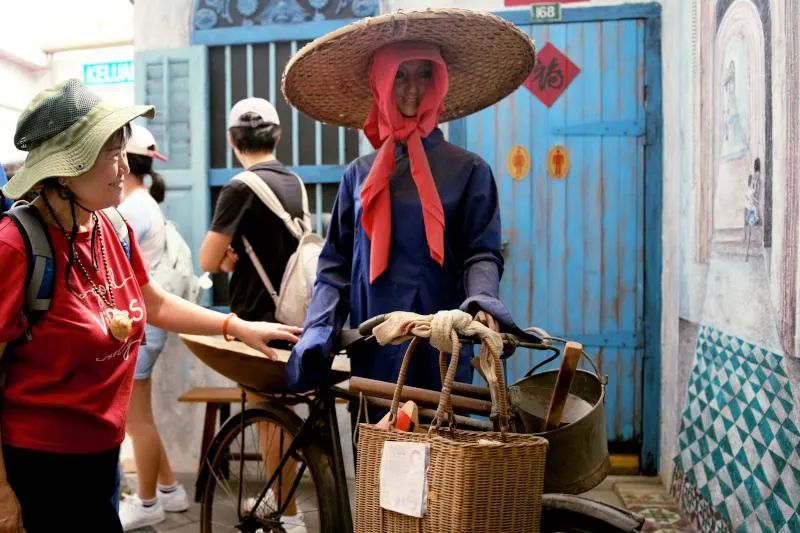
This three-story building displays various aspects of the Hakka miners' lives during that time. Exhibits include aspects of opium consumption, gambling halls, and prostitution, which were prevalent and largely unregulated during that era.


A section on the ground floor explains the tin processing methods, while another on the first floor details how the Hakka clans arrived in Malaysia from China.
9. Concubine lane 二奶巷

Concubine Lane in Ipoh is a vibrant tourist attraction just a few minutes walk from Han Chin Pet Soo. In the last century, this tiny lane served as a residence for the mistresses of wealthy tycoons. However, no mistresses live here anymore nowadays, and most houses have been converted into shops and eateries.
The shops are vibrant, and many still preserve the old architectural style. Numerous vendors sell tasty foods and attractive souvenirs, and the lane has become quite congested, transforming from a back alley into a bustling tourist area.
Concubine Lane is one of the best places to visit in Ipoh. We were here several months ago and published a separate article and video about our experience. Please refer to our article for more details about Concubine Lane.
10. D R Seenivasagam Recreational Park
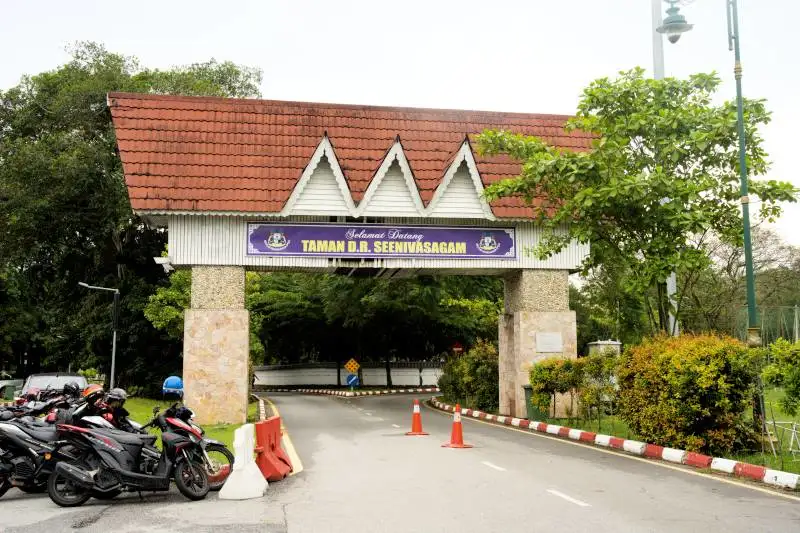
When we were young, our parents always brought us to D.R. Seenivasagam Recreational Park to ride bicycles, walk around, or relax in the evening. It is one of Ipoh's most popular recreational parks. The park has football fields, beautiful garden with picturesque views, and a children’s playground. It's a gathering place for locals to engage in group activities like exercise and dancing, among many others. There’s also a jogging trail where you can see locals exercising in the evening. If you want to take a break from your hectic schedule, you can come here and relax just like the locals do.

11. Qing Xin Ling Leisure & Cultural Village 清心嶺

I visited Qing Xin Ling twice during my previous trip to Ipoh. It is for sure one of the best places to visit in Ipoh, as it encompasses a large area at the foothills of a limestone hill and recreates the ambiance of old Ipoh from the 1960s to the 1970s.
There, you can find replicas of typical houses from that era, along with items commonly used at the time, such as old black-and-white TVs, gramophones, and old streets with traditional noodle shops, barber shops, and more.
It is currently temporarily closed, but I hope it will reopen soon. While there, we took photos and made a video about our visit, which you can view here.
12. Sunway Lost World Theme Park

After visiting all the Cave Temples, we drove to the Sunway Lost World Theme Park (also known as Lost World of Tambun) , the largest theme park in Ipoh.
Since we didn’t plan to enter the theme park, we checked out the location and the entrance ticket cost. Waze's directed us to a parking lot that was not entirely accurate. However, someone on-site helped us find the correct parking area.

The theme park was open until 11:00 PM, but since we had no intention of going in, we only took some photographs outside and visited the souvenir shop.
13. Mirror Lake

Every time we visited the Kin Loong Valley Chang Jiang White Coffee shop, we would pass by Mirror Lake One and Two on our right. Ironically, despite our frequent visits, we had never explored either lake. Today, we decided to check whether these lakes were worth including in the list of best places to visit in Ipoh.

According to the staff, Mirror Lake One is more attractive than Mirror Lake Two. Although Mirror Lake One was temporarily closed due to flooding, we could still visit the petting zoo and the mining tunnel leading to the lake. Unfortunately, we were not allowed to enter the tunnel further because of the flood, so we only managed to take some photographs around that area. Naturally, we headed to visit Mirror Lake Two, which was open.

We arrived at Mirror Lake 2, a mere 100 meters from Mirror Lake 1. After purchasing the tickets, we board a small boat that could accommodate eight people plus the boatman. The boat would pass through a tunnel over 100 meters long to reach the lake, which sounded exciting.

To our dismay, there was no light inside the tunnel. It was completely dark inside the tunnel, and we couldn’t even see our fingers. What a bummer!

Once we emerged from the tunnel, we found ourselves at Mirror Lake 2, a serene body of water embraced by limestone hills. Monkeys playfully leaped from tree to tree, adding a touch of life to the tranquil scene. Although the charm of the lake was undeniable, there wasn’t much else to draw attention to.

Overall, I didn’t think it was worth the price of admission, especially considering that it is much smaller than Luon Cave in Ha Long, which we visited before. You can watch our videos from our trip here.
14. Gerbang Malam

The last destination we want to highlight is the night market in Ipoh, Gerbang Malam. It is in Ipoh New Town, with numerous restaurants and eateries. The market comes to life at night, making it a perfect place to stroll after dinner and shop for items such as clothes, shoes, souvenirs, and toys. The road is closed to vehicles at night, allowing stalls to be set up and shoppers to walk safely without worrying about the traffic.

15. Food of Ipoh
Ipoh is renowned for its food, particularly its street food. There is so much to explore that we've created two separate articles: one focused on the famous street food and the other on well-known restaurants in Ipoh. It makes no sense to do only the best places to visit in Ipoh without experiencing the local food and dining options. Please read these two articles before planning your trip to Ipoh, and along with this guide on places to visit, I hope you have a wonderful time in Ipoh.
Bonus: Other places worth to visit near Ipoh
If you have more time to stay in Ipoh, consider visiting nearby places that are within a 30 to 45-minute drive. One of the best attractions is Kellie’s Castle in Batu Gajah. Another exciting activity is white water rafting on the Kampar River. To experience rafting, you will need to head to a small town called Goping, which is less than a half-hour drive from Ipoh. We have visited all these places before, and you can refer to additional articles for more information.
🎞️ Watch the video: Best places to visit in Ipoh
Please watch the video we made for our trip on YouTube by clicking the image below

